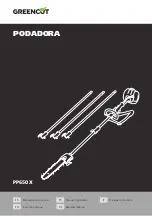
Page 2
Installing the Blade
When setting the saw up the first time, follow the instructions as outlined below.
1. Open the front cover. Position the diamond blade around the lower wheel and into
the right and left guide channels with the diamond surface facing the saw front. DO
NOT bend or twist the blade at any time during installation or use.
2. Use one hand to grasp the bottom of the upper wheel between two spokes and
gently pull the bottom of the wheel towards you (approximately 3/8″ - you should
feel it move easily initially and then “hit” and not want to go further without
forcing), then pull the wheel down enough to place the blade around the upper
wheel using your other hand.
3. Slowly release the wheel, making sure the blade remains on both wheels and passes
through the right and left channels.
4. Tracking, the position of the blade on the wheels, is controlled by adjusting the tilt
of the upper wheel. Check the tracking by rotating the lower drive wheel several revolutions by hand while watching the position
of the blade on the wheels. The blade should remain centered on both wheels. If the blade isn’t centered or comes off either
wheel, you will need to adjust the tracking and alignment as outlined in the next section. If the blade rides centered on the wheels
skip to Installing the Work Table.
Adjusting Blade Tracking and Alignment
The wheels are factory aligned so that the position of the blade is controlled by adjusting
the upper wheel tilt. On the back of the upper housing is the tension device with a nylon tilt
adjustment screw in the middle. Be aware that any changes made to the blade position on the
upper wheel will have the opposite effect on the blade’s position on the lower wheel. Read
through the possible problems below to find the one that best describes what is happening
when you hand turned the wheel and follow the instructions for fixing it. Make all adjust
-
ments in small increments.
1. If the blade “walks” off the front of the upper wheel
: Tilt the top of the upper
wheel backward by turning the nylon tilt adjustment screw to the right (clockwise).
Make 1/2 turn adjustments and test the effect on tracking by hand turning the lower
wheel. Repeat as necessary until the blade remains in the correct position.
2. If the blade “walks” to the back of the upper wheel
: Tilt the top of the upper wheel
forward by turning the nylon tilt adjustment screw to the left (counter-clockwise).
Make 1/2 turn adjustments and test the effect on tracking by hand turning the lower
wheel. Repeat as necessary until the blade remains in the correct position.
3. If the blade “walks” off the lower wheel
: This indicates that the upper and lower
wheels are not in alignment with each other. The lower (fixed) wheel is closer to the
back of the frame than the upper (adjustable) wheel. The lower wheel should be 1/2”
from the inside of the frame. You can check this with a ruler or scale. The lower
wheel can be moved in or out by inserting the 5/64” long arm Allen wrench through
the hole in the lower left side of the saw’s frame and loosening the set screw on the
brass arbor. Move the wheel to the correct position, check with the ruler or scale, and
secure the set screw.
Blade Tension
Proper blade tension is important for cutting ease and obtaining maximum blade life. The tension springs lessen the stress that twists and
pulls put on the blade to maximize blade life. All Inland saws have tension springs preset for a blade 37.7" in circumference (+ or - .005")
- the exact dimension of Inland brand blades. If you use an Inland blade you should never have problems with tension. Some competitors
make blades that are only 37.2" and so will have too much tension on them which could shorten blade life.
We highly recommend the use
of Inland brand blades for all Inland brand saws.
We are the only saw manufacturer that manufactures its own diamond products making
our diamond blades significantly less expensive and designed to give you the best performance.
Installing the Work Table and BladeSert™
Place the molded table on the table supports with the split facing the front of the saw. Use a
flat blade screw driver to attach the table using the four (4) 10-24 1/2″ Nylon Screws. Take
care not to over tighten.
Place the BladeSert into the work surface making sure the blade passes through the slot and
the split faces the saw front. Our patented BladeSert eliminates the need for upper blade
guides by providing blade support where it is most crucial: at the point of sawing.






















